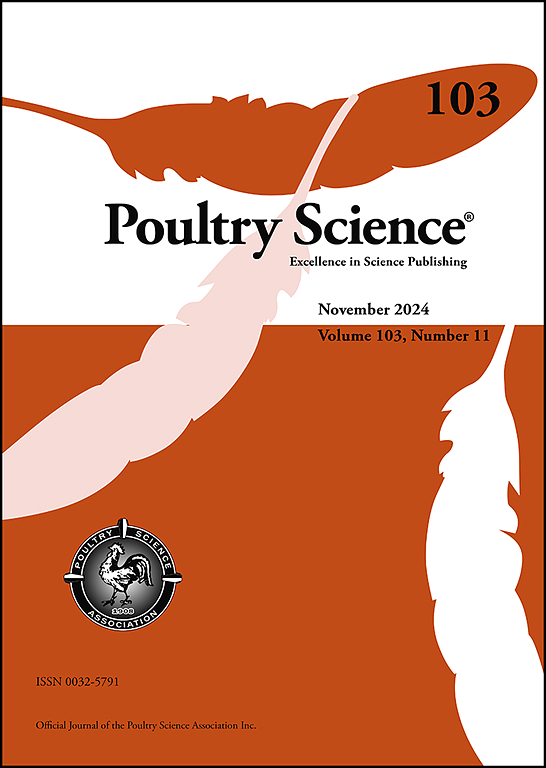Consequences of dietary olive leaf powder supplementation on growth performance, carcass traits, blood biochemical parameters and gut microbiota in broilers
IF 3.8
1区 农林科学
Q1 AGRICULTURE, DAIRY & ANIMAL SCIENCE
引用次数: 0
Abstract
This experiment examined the potential of olive leaf powder (OLP) as a natural growth enhancer in broiler feed and its influences on growth performance, carcass characteristics, blood parameters, and intestinal bacterial count. A total of 210 one-day-old Arbor Acres chicks were randomly allocated into three groups. The control group was given a basal diet only, the 2nd and 3rd groups were given basal diet supplemented with 1 g OLP and 2 g OLP/kg diet, respectively. Each group consisted of seven replicates with 10 unsexed chicks each. The experimental trial lasted for thirty-one days. Results showed that, the OLP2 group exhibited a significant increase in live body weight (LBW) at days 14 and 21 of age, whereas the OLP1 group experienced a considerable rise in body weight gain (BWG) between days 29 and 31 of age. Average daily feed intake (ADFI) considerably decreased during the first 8–14 days of the trial, but increased during the next 29–31 days throughout the entire duration (1–31 days). While, Feed conversion ratio (FCR) was improved in OLP groups during the 15-31 days of trial. Carcass and breast yields improved significantly with OLP supplementation, while abdominal fat content was reduced. Blood analysis revealed considerable enhances in total protein, albumin, and globulin levels in both OLP groups, while alanine transaminase (ALT), creatinine, total cholesterol (TC), triglycerides (TG), and very low-density lipoprotein (VLDL) levels were considerably reduced. Notably, immunity and antioxidant markers showed significant improvement with 2 g OLP supplementation. Due to OLP supplementation, the number of beneficial bacteria such as Lactobacillus rose while the number of all harmful bacteria (E. coli and Clostridium) in caecal samples declined. In conclusion, OLP supplementation at 1 g and 2 g per kg of feed demonstrated a significant positive impact on broiler growth performance, carcass quality, lipid profile, immunity, antioxidant status, and raised the number of beneficial bacteria in the caecal contents of the broiler chickens, making it a promising natural growth promoter in poultry production.
求助全文
约1分钟内获得全文
求助全文
来源期刊

Poultry Science
农林科学-奶制品与动物科学
CiteScore
7.60
自引率
15.90%
发文量
0
审稿时长
94 days
期刊介绍:
First self-published in 1921, Poultry Science is an internationally renowned monthly journal, known as the authoritative source for a broad range of poultry information and high-caliber research. The journal plays a pivotal role in the dissemination of preeminent poultry-related knowledge across all disciplines. As of January 2020, Poultry Science will become an Open Access journal with no subscription charges, meaning authors who publish here can make their research immediately, permanently, and freely accessible worldwide while retaining copyright to their work. Papers submitted for publication after October 1, 2019 will be published as Open Access papers.
An international journal, Poultry Science publishes original papers, research notes, symposium papers, and reviews of basic science as applied to poultry. This authoritative source of poultry information is consistently ranked by ISI Impact Factor as one of the top 10 agriculture, dairy and animal science journals to deliver high-caliber research. Currently it is the highest-ranked (by Impact Factor and Eigenfactor) journal dedicated to publishing poultry research. Subject areas include breeding, genetics, education, production, management, environment, health, behavior, welfare, immunology, molecular biology, metabolism, nutrition, physiology, reproduction, processing, and products.
 求助内容:
求助内容: 应助结果提醒方式:
应助结果提醒方式:


